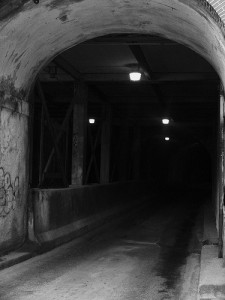 In a recent post, Elizabeth Merritt, the founder of the American Association of Museum’s Center for the Future of Museums, gave a good synopsis of impending threats to nonprofit status that the arts may well be facing in the near (or immediate) future. (Dark Futures: Nonprofit Fragmentation) The essence of the argument is that in a time of budgetary despair for government, there is great pressure to examine the legitimacy of the tax benefits granted the nonprofit sector. We are already seeing the proliferation of voluntary (and not-so-voluntary) PILOTs (payments in lieu of taxes) and crowds at the barricades questioning the nonprofit status of gigantic hospitals and amply endowed universities.
In a recent post, Elizabeth Merritt, the founder of the American Association of Museum’s Center for the Future of Museums, gave a good synopsis of impending threats to nonprofit status that the arts may well be facing in the near (or immediate) future. (Dark Futures: Nonprofit Fragmentation) The essence of the argument is that in a time of budgetary despair for government, there is great pressure to examine the legitimacy of the tax benefits granted the nonprofit sector. We are already seeing the proliferation of voluntary (and not-so-voluntary) PILOTs (payments in lieu of taxes) and crowds at the barricades questioning the nonprofit status of gigantic hospitals and amply endowed universities.
The likelihood is that a public re-examination of 501(c) status is on the horizon. (For those unaware, 501(c)(3) is only one of the tax exempt status categories, but it is the one into which most nonprofit arts organizations fall.) This will apply to all nonprofits and will likely have a strong element of evaluating the relative worthiness of the differing elements of the field, once again raising the question of social service providers versus all others, including the arts. And, for all the legitimate arguments to the contrary there is a fairly broad-based assumption on the part of the public that the arts are for those with money, education, and/or power–not the 99% or 47% or whatever clichéd percentage you choose to employ.
Whenever some segment of the arts community sounds as if it feels entitled to public support, whenever there is artcentricity (focus on the art rather than its impact on people), whenever there is out-of-hand dismissal (based on stilted notions of curatorship and/or “quality”) of calls for community awareness in programming, this unfortunate (and now potentially debilitating) assumption is bolstered.
It is critical for the future health of the arts sector that we act preemptively to change the perception. As I have said before, we must come to be seen as valuable by being valuable to communities. (Matter by Mattering) This is not to say that there is not good work happening. Far, far from it. However, in the face of this looming threat, all arts organizations must examine their relationships with communities (of every kind) around them and learn (and work) to more fully
Engage!
Doug
Photo:![]()
![]() Some rights reserved by Mr. Ducke
Some rights reserved by Mr. Ducke

We don’t have a real “budgetary despair” in government. What we do have is a conservative neo-liberal agenda being acted out in our political system that doesn’t want government involved in anything but the military and corporate subsidies.
This right wing agenda doesn’t want to support our cultural institutions and cultural producers. And those leading the agenda have cleverly figured out that a good attack on those institutions and producers is to say that they aren’t doing things the way the people want them to be done.
Your argument plays right into their hands.
I would argue a little differently. While there is no question that a neoliberal agenda is “against anything that isn’t” part of the market economy, the pressure wrt property tax exemptions has to do with the fact that most cities are dependent on property tax revenue for the bulk of their budgets, and center cities especially have a preponderance of large nonprofit organizations based in their city, vis-a-vis other jurisdictions, and a very large proportion of the city’s land tends to be owned by nonprofits. Plus many cities aren’t on the upswing financially (e.g., DC or SF or NYC vs. Detroit or Providence, etc.) so they don’t see the ability to continually raise property taxes on residents as having a lot of momentum.
Rather than “lose the tax exemption” I think the solution is to better balance “payment” of the tax exemption at the metropolitan, rather than the city scale.
Some regions, Detroit recently, have passed millages to support arts institutions on a regional basis. But in my opinion, the only region that has done this right is Pittsburgh-Allegheny County. They created what is called the “Regional Asset District” and it supports cultural institutions across the county, to reduce the burden on Pittsburgh proper for having most of the major institutions, which serve regional audiences.
It would behoove the arts community to arm themselves with knowledge about these kinds of initiatives, because most of the initiatives in my opinion fall far short of what was done in Allegheny County. (E.g., the tax on cigarettes in Cuyahoga County OH to support the arts is a perfect example of taking from the less fortunate to help the better off, even though I detest smoking, it’s not the right kind of tax.)